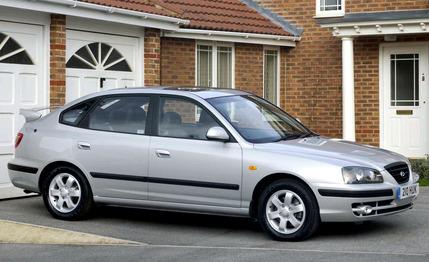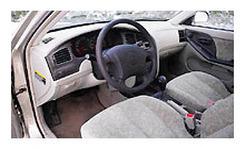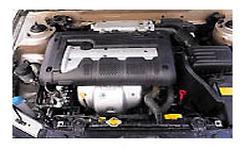 First Drive Review
First Drive Review
Now that many small Japanese cars have grown bigger and more expensive, there's a slot up for grabs at the bottom of the market for any automaker capable of taking advantage of the situation. Ford's Focus has moved in with a will for those who like that car's edgy styling. But there's room for the Koreans, too, particularly Hyundai, whose steadily improving quality and original styling have marked it as a company with real determination.
The Elantra has taken great strides with each new iteration, and the third-generation 2001 model keeps up that momentum with much-improved levels of isolation, available space, and style. With a 2.3-inch-longer wheelbase and a roofline designed to provide better headroom, the new Elantra GLS (there's only one trim level) is now sized much more in keeping with western expectations.
Riding on a 102.7-inch wheelbase, the 2001 Elantra offers 54 cubic feet of space in front and 41 in the rear. The seats are larger, featuring a six-way adjustable driver's seat, and the headrests and seatbelt anchor points adjust as well to further improve comfort.
The styling that goes along with the enlarged bodywork is kind of pugnacious in front, with a prominent grille and glaring clear-lens lights, but it looks refreshingly elegant from the rear. Hyundai claims a 12-percent improvement in aerodynamic efficiency (Cd, 0.33), which should improve both fuel economy and wind noise.
 Although the interior design is somewhat predictable -- very much like the typical cockpit treatment in recent Japanese cars -- it's well equipped and easy to use. The gauges are big and clearly legible, and the ventilation system has large rotary switches.
Although the interior design is somewhat predictable -- very much like the typical cockpit treatment in recent Japanese cars -- it's well equipped and easy to use. The gauges are big and clearly legible, and the ventilation system has large rotary switches.
The new Elantra can even boast having side airbags along the front seats, quite a novelty for its price. That sticker, by the way, tops out at $14,884 if you order the high-level "package five" option on a car with an automatic transmission. Included are anti-lock brakes, remote keyless entry, four-wheel disc brakes, and traction control.
The base price is just $12,934 with the five-speed manual transmission (which undercuts Honda's cheapest 1.7-liter two-door Civic by $266). In that form, it comes with air conditioning, a radio and cassette stereo system, power at the windows, locks, and mirrors -- all of which cost extra at Honda -- plus a split-folding rear seat and full instrumentation.
Powered by Hyundai's 140-hp, twin-cam, 2.0-liter Beta engine (now subframe-mounted, with a ribbed block, eight-counterweight crank, and hydraulic engine mounts for better suppression of noise, vibration, and harshness), the 2001 Elantra zips about at a brisk pace, with noticeably improved smoothness. An intake resonator cuts induction honk appreciably, and a muffler with a bypass valve that only opens at higher revs further stifles low-speed engine noise (by 4 dBA, Hyundai claims). As a result, the quietness and smoothness are quite striking.
Although the steering is a tad remote, the Elantra rides and handles fairly well on its strut-front, multilink-rear suspension, with body motions that are effectively damped. Gas-filled shocks are standard for 2001, but the Hyundai still tends to bobble slightly on rippled surfaces rather than soak up the bumps.
 The Elantra's four-speed automatic has what Hyundai calls Hyundai Intelligent Vehicle Electronic Control (HIVEC), a grandiose way of saying it has a fuzzy-logic system to minimize persistent up- and downshifts on grades. Although not as well integrated as the automatics from, say, GM or Lexus, the shift quality and kickdown action in the Elantra's transmission are perfectly acceptable for a compact econocar.
The Elantra's four-speed automatic has what Hyundai calls Hyundai Intelligent Vehicle Electronic Control (HIVEC), a grandiose way of saying it has a fuzzy-logic system to minimize persistent up- and downshifts on grades. Although not as well integrated as the automatics from, say, GM or Lexus, the shift quality and kickdown action in the Elantra's transmission are perfectly acceptable for a compact econocar.
The standard five-speed manual worked fluently on our short preview drive, with what seemed like decently stacked ratios. Fourth is actually slightly underdriven, at 1.06:1, and makes a pretty good passing gear. There's a sense of mechanical transparency about the Elantra that makes it easy to live with. The company's comprehensive warranty (10-year/100,000-mile powertrain, five-year/60,000-mile bumper-to-bumper) should make the car's purchase easy to justify, too.
Above all, though, the Elantra's new levels of refinement argue against the usual proposition that it's better to buy a used Honda or Toyota instead of a new Korean car. And wait until you see the three-door hatchback Elantra GT we'll get next year. To use a word not commonly associated with things Hyundai, it's hot.